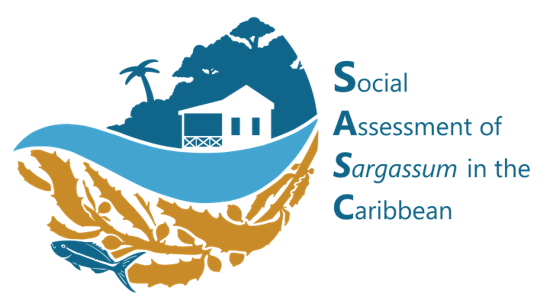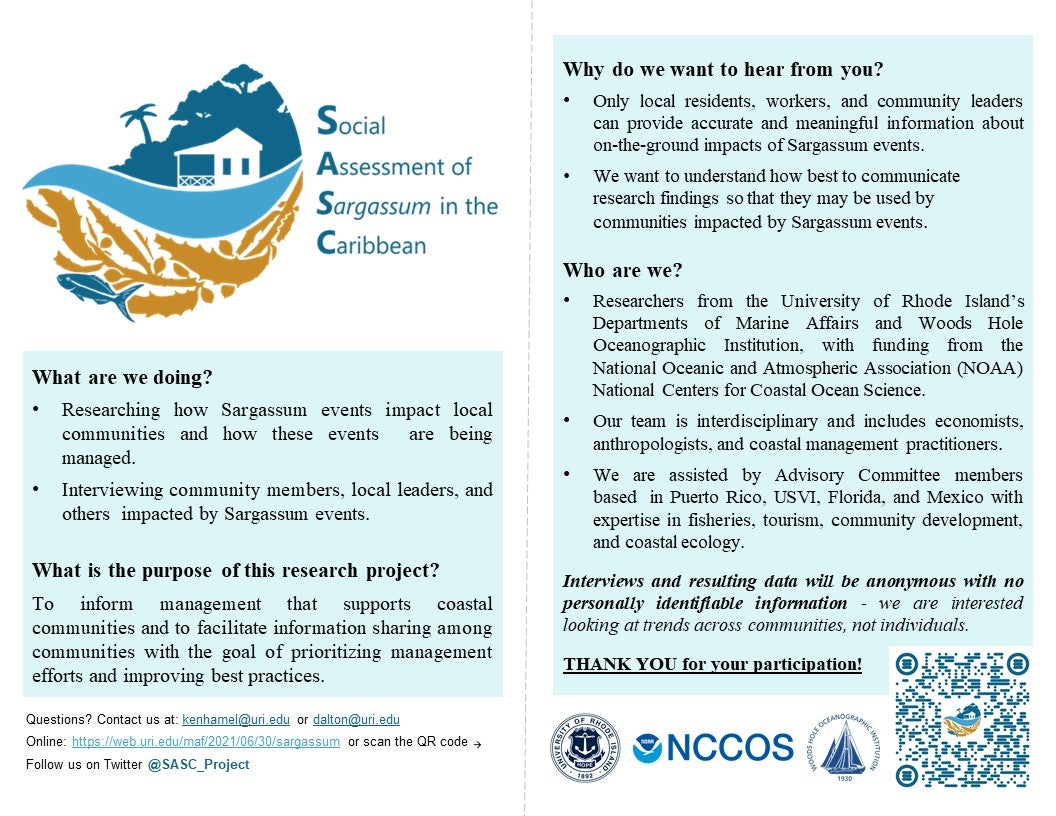Tracey Dalton, Carlos Garcia-Quijano, Di Jin, Peter Freeman, Ken Hamel, Patricia Valentin-Llorens This study explores how Sargassum events and management strategies impact people who live and work in the Caribbean region.
This study explores how Sargassum events and management strategies impact people who live and work in the Caribbean region.
Project Background
In recent years, the number, size and distribution of macroalgal blooms have increased globally. In the Caribbean and Gulf of Mexico regions, Sargassum accumulations on shore and in the water have become an increasingly persistent and severe nuisance since first appearing in 2011.
The impacts of these harmful algal bloom (HAB) events are still poorly understood. However, mounting evidence suggests that the size and frequency of these blooms pose unprecedented environmental, social, and economic risks, including threats to tourism, property values, fisheries, aquaculture, public health, and quality of life.
Management responses to these HAB events vary considerably from place to place and can include the use of floating barriers and removal technologies, manual and mechanical removal of beached macroalgae, and transport and disposal of removed biomass, often to unlined landfills or illegal dump sites. These management activities pose unique challenges, yet are largely unstudied. Additionally, lack of coordination within and between communities, concerns about public safety, equity considerations, lack of policy development, and lack of authoritative best practice guidelines complicate management efforts.
Our social science research team is collaborating with partners in the region who represent tourism, fisheries, environmental health, community development, and coastal resource management to (1) characterize the nature and severity of Sargassum events in the wider Caribbean; (2) investigate human well-being, local ecological knowledge, and individual attitudes, values and behaviors associated with Sargassum events across the Caribbean region; and (3) analyze economic impacts of Sargassum events.
Project Activities to Date
Online Survey on Sargassum in the Caribbean: Incidence, Impacts, and Management (Aug to Oct 2021)
This survey closed Nov 8, 2021. We are currently analyzing survey data.
Fieldwork in Coastal Communities (June 2022 – June 2023)
In the summer of 2022, we visited Puerto Rico and the U.S. Virgin Islands, followed by Quintana Roo, Mexico later that year, to learn more about Sargassum impacts there. In spring/summer of 2023, we visited the Florida Keys. In each community, we talked with community members, local leaders, fishers, and others impacted by Sargassum events. We are currently synthesizing results.

Funder: NOAA’s NCCOS Prevention, Control, and Mitigation of Harmful Algal Blooms Program
Research Team
Tracey Dalton, PhD
Professor, Department of Marine Affairs
Director, Rhode Island Sea Grant
University of Rhode Island
401‐874‐2434
dalton@uri.edu
Carlos Garcia-Quijano, PhD
Associate Professor
Departments of Anthropology & Marine Affairs
University of Rhode Island
401‐874‐4297
cgarciaquijano@uri.edu
Di Jin, PhD
Senior Scientist
Marine Policy Center
Woods Hole Oceanographic Institution
508‐289‐2874
djin@whoi.edu
Peter Freeman, M.S.
Coastal Research Associate
Coastal Resources Center
University of Rhode Island
401‐874‐6645
pfreeman@uri.edu
Graduate Students
Ken Hamel, M.S.
PhD Candidate
Department of Marine Affairs
University of Rhode Island
808-748-1963
kenhamel@uri.edu
Patricia Valentin-Llorens, B.A.
Master’s student
Department of Marine Affairs
University of Rhode Island
patriciavll@uri.edu
Press releases and related online material:
• https://web.uri.edu/research-admin/noaa-awards-11-6-million-for-harmful-algal-bloom-research/
• https://coastalscience.noaa.gov/project/assessing-societal-impacts-of-harmful-macroalgae-blooms-in-the-caribbean/
